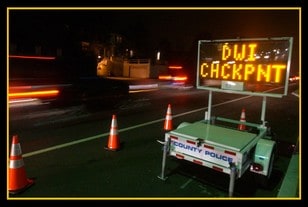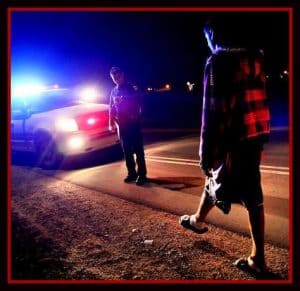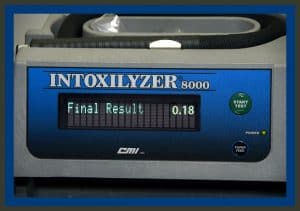DWI Arrest Process Overview
DWI:
D.W.I. is an acronym that refers to the operation of motor vehicles in contravention of alcohol related driving laws. DWI stands for “Driving While Intoxicated.” DUI or “Driving Under the Influence,” is sometimes used to refer to the same type of violation in states other than New York.
A DWI offense is said to occur when a driver is found to have a blood alcohol level at or above the legal limit. The legal blood alcohol concentration (BAC) level is 0.08 percent of one per centum or more by weight of alcohol or 8 grams of alcohol per 100 deciliters of blood. Any driver who is stopped for erratic driving or for other reasons, whom an officer reasonably believes has been drinking, can be asked to take a breath test or blood test.

STOP & TESTING:
Once a police officer has stopped a suspected driver, after inquiring from the motorist about their drinking, he or she is usually asked to breathe into a preliminary screening device commonly known as an alco-sensor. While these test results are not admissible at trial, these are used as part of the “probable cause” to arrest the driver.
Next, a field sobriety test will typically be administered. Standardized field sobriety tests (SFSTs) in suspected DWI stops usually include:
- The Horizontal Gaze Nystagmus;
- The One Leg Stand; and
- The Walk & Turn.
These three SFSTs have gained prominence in recent years as seemingly effective, objective, easy to administer methods of determining intoxication or impairment. In an effort to standardize SFST’s, the National Highway Traffic Safety Association (“NHTSA”) has adopted these Standardized Field Sobriety evaluations for use by police officers nationwide:


The Horizontal Gaze Nystagmus Test:
The Horizontal Gaze Nystagmus (HGN) is essentially a measurement of eye movement. Nystagmus means a jerking of the eye. The perpendicular jerking of the eye measured by this test is measured three different ways. The first is to measure the angle of onset of the nystagmus. By measuring the angle at which the eye begins jerking, an officer can, theoretically, roughly estimate BAC. The second method is to determine whether the nystagmus becomes more “distinct” when the eye is moved to a lateral extreme. The third technique is to look for a lack of “smooth pursuit”; that is, rather than following a moving object smoothly, the eye jumps or tugs.
If an officer determines the driver has “failed” these tests and that they should be arrested, he or she is taken to the police station usually for further chemical breath testing. The chemical test is given by the use of an intoxilyzer, breathalyzer, or sometimes a blood or urine test. A driver who is found to have a BAC of 0.08% or higher is issued an appearance ticket for a future court date or is held in custody until he or she can appear before a judge for bail to be set, and then be directed to appear at a future court date.
The One Leg Stand
Administration
The one leg stand requires the police officer:
- Tell the subject to stand with feet together, and arms at side;
- Tell the subject not to start the test until instructed to do so;
- ask the subject if they understand;
- Tell the subject to stand on one foot, with the other foot held straight about six inches off the ground, toes pointed forward and parallel to the ground;
- Demonstrate the stance;
- Tell the subject to count from 1 to 30, by thousands;
- Temonstrate the count, for several seconds;
- Ask the subject whether they understand; if not, re-explain whatever is not understood;
- Tell the subject to begin; and
- Allow the subject to resume the test at the point of interruption, should the subject stop or put the foot down, and not require that the count begin again at “one thousand and one”.
Testing Clues
During the test, officers are trained to look for the following validated clues as signs of impairment.
- Swaying;
- Putting the foot down;
- Hopping; and
- Raising the arms from the sides (6 inches or more).
Test Scoring
The test is to be scored objectively, giving one point for each indicia of intoxication. However, many officers do not employ an objective method of scoring. Instead, if a suspect does not perform up to the officer’s expectations, he or she is most often arrested.
The Walk and Turn Test:
Administration
 The Walk and Turn test requires that the officer:
The Walk and Turn test requires that the officer:
- Begin by having the subject assume the heel-toe stance;
- Verify that the subject understands that the stance is to be maintained while the instructions are given;
- Cease giving instructions if the subject breaks away from the stance, and have the subject resume the stance before continuing; tell the subject that they will be required to take 9 heel-to-toe steps down the line, to turn, and to take 9 heel-to-toe steps up the line; demonstrate several heel-to-toe steps;
- Demonstrate the turn;
- Tell the subject to keep the arms at the sides, to watch the feet, to count the steps aloud, and not stop walking until the test is completed;
- Ask the subject whether they understand; if not, re-explain whatever is not understood;
- Tell the subject to begin; and
- Allow the subject to resume from the point of interruption, and not from the beginning, should the subject stagger or stop.
Testing Clues
The eight validated clues that officers are trained to look for as signs of intoxication are as follows:
- Loses balance during instructions (breaking away from the heel-toe stance);
- Starts walking too soon;
- Stops while walking;
- Misses heel-to-toe while walking (misses by at least one-half inch);
- Raises arms (at least six inches or more) from side while walking;
- Steps off the line;
- Turns improperly; and
- Takes the wrong number of steps.
Test Scoring
A point is to be given for each indicia manifested by the suspect. As with the one leg stand, a score of 2 is unsatisfactory.

FORMAL ARREST
When a law enforcement officer has determined he has probable cause to make an arrest for the crime of Driving While Intoxicated, a series of events follow. Understand that each officer’s particular policies vary and this is a general overview of what to expect.
First, an officer will likely tell you to turn around and place your hands behind your back and the officer will apply handcuffs to you. If this command is given, and no matter how surreal the situation seems, it is in your interest to comply. The handcuffs may be uncomfortable and it is likely that the officer will check the fit and ask you about the comfort level. Often as the officer is doing this he will tell you that you are under arrest for DWI/ DUI and recite the famous Miranda Warning of rights: “You have the right to remain silent…You have the right to an attorney…”
Some of the best advice any criminal defense attorney can offer to you is to heed these warnings and exercise these rights. The officer is trained to observe and write down, word-for-word, each comment that comes out of an arrestee’s mouth. This is not the time to explain to the officer anything about the case – no amount of talking is going to remedy your problem at this point. Next you will be placed in the back of a police cruiser while the officer deals with your vehicle. In New York State the officer is required to impound the vehicle. The officer may need to wait for up to 30 minutes for the tow driver to arrive, or this task may be delegated to another officer.
BREATHALYZER TEST PERFORMED AFTER ARREST AT POLICE STATION
Police officers use Breathalyzer machines to determine a driver’s blood alcohol content (BAC). In every state, it is illegal to drive with a blood alcohol content of .08% or higher. While breath test results can be used against a driver in the court of law, there are many flaws that surround DWI breath tests. For example, even the most up-to-date breathalyzer machines simply read the alcohol concentration found in your blood. This test does not take into account certain factors such as your gender, your weight and the speed at which your body can metabolize alcohol when compared to an average person.
 And like any other machine ever created, malfunctions can and will happen. Perhaps the breath test machine was not working properly at the time and therefore your results read much higher than they actually were. The police officer that administered your breath test must have also undergone proper training on that particular machine. Other factors that may contribute to an inaccurate breath test result, for example, may be the way it was performed, if you were belching, exposed to certain chemicals or if you had trace amounts of alcohol on your breath from mints, cough syrup or mouth wash.
And like any other machine ever created, malfunctions can and will happen. Perhaps the breath test machine was not working properly at the time and therefore your results read much higher than they actually were. The police officer that administered your breath test must have also undergone proper training on that particular machine. Other factors that may contribute to an inaccurate breath test result, for example, may be the way it was performed, if you were belching, exposed to certain chemicals or if you had trace amounts of alcohol on your breath from mints, cough syrup or mouth wash.
Urine testing is the least accurate method and is rarely ever performed. The scientific community regards blood testing as the most reliable and accurate method of measuring blood alcohol concentration, but it is inconvenient for police since it must be drawn from a licensed professional. Breath testing is more convenient for police, but its reliability and accuracy have been debated.
The most common argument against breath testing is that the machine might misread other common substances as alcohol. However, nobody other than law enforcement is allowed to test the machine for reliability and accuracy. Additionally, other factors can affect results, for example, the way the test was performed, if you were belching, exposed to certain chemicals or if you had trace amounts of alcohol on your breath from mints, cough syrup or mouth wash. Even a sober person with a fever will have a higher breath test reading than they would without a fever.
Judgment, coordination and ability to drive a vehicle change when one consumes any amount of alcohol. The level of impairment depends on five conditions:
- Amount of alcohol;
- Whether food was eaten before or while drinking alcohol;
- Length of time since alcohol was imbibed;
- Body weight; and
- Gender.
There is no quick method to become sober. The best method is to wait until your body absorbs the alcohol. The average rate that your body processes alcohol is approximately one drink per hour.
Beginning the Breath Alcohol Content (BAC) Testing Procedure
20 Minute Observation Period
Breath tests that are sought to be admissible as evidence in a criminal case in New York State are performed via BAC DataMaster machine. The first step in this process is for the officer to visually check your mouth for any foreign objects to begin the “20 minute observation period.” The officer must ensure that there are no foreign objects – food, jewelry, etc., is in your mouth for at least twenty minutes prior to the breath test. The officer is also required to maintain constant observation in order to ensure that you do not vomit, belch, eat, drink, or otherwise get anything in your mouth that may taint the test which is going to be administered.
Implied Consent By Motorist To Chemical Test
Next the Officer will read, or have you read for yourself, the “Refusal Warnings.”
- You are under arrest for driving while intoxicated.
- A refusal to submit to a chemical test, or any portion thereof, will result in the immediate suspension and subsequent revocation of your license or operating privilege, whether or not you are found guilty of the charge for which you are arrested.
- Your refusal to submit to a chemical test, or any portion thereof, can be introduced into evidence against you at any trial, proceeding, or hearing resulting from this arrest.
- Will you submit to a chemical test to determine the alcohol or drug content of your blood?
After going over this the officer should ask you if you have any confusion – if you do it is imperative that you state what the confusion is and seek to discuss this process with an attorney so you must demand to speak with one. Many officer’s will NOT read you these warnings until AFTER you speak with an attorney which is problematic because you did not have questions about these warnings until that conversation was done and some officer’s will refuse to let you speak to one again. If this happens it is of the utmost importance that the “confusion” or “questions” you have about the Implied Consent Warnings be documented. In fact, unless you consider yourself an expert of New York DWI law, licensing consequences and the evidentiary implication of submitting or refusing a breath test you should be confused about the legal jargon that is contained on the form. Tell the officer you are confused if you don’t completely understand anything on the form and demand the opportunity to speak with an attorney in order to answer your questions.
It is important to remember that you have the right to refuse the test, but…your refusal to take the test can be used against you in plea negotiations and as an adverse inference of guilt at trial. If you refuse a blood test (mandatory in DWI accidents involving personal injuries) the officer may apply for a search warrant for you blood via a judge. With a search warrant the officer would take you to a medical facility, most likely a hospital, and have your blood drawn against your will. In this instance the prosecutor now has two pieces of evidence, a refusal to show “consciousness of your guilt,” and a blood result that may show evidence of guilt. The use of a search warrant to secure blood alcohol concentration evidence is not new, but it is becoming more common when there is a refusal. Citizens are presumed to know the law so it is important to realize these additional consequences of a breath test refusal.
The Breath or Blood Test
Usually after the person is placed under arrest, he/she will be taken to the police station and will be asked to blow into a machine called the Intoxilyzer Model 5000. This machine will measure the blood alcohol content of the breath sample.
The machine or instrument will prompt the officer for information and at the appropriate times the officer will place a disposable plastic mouthpiece on the end of a tube from the machine and tell you to blow and blow and blow until he tells you to stop. The machine is programmed to identify when a ‘sufficient’ amount of air has been provided into the machine and it will make a beep. The machine will accept as little as 5 seconds of air, but the police officers are trained to have you blow for as long as physically possible because, as the saying goes, “the longer you blow, the higher it goes!” After two sufficient blows and the machine runs several other processes a breath test ticket with the results of the “blow” will be produced by the machine. It is a carbon copy ticket and you should be provided with a copy.
Once the test is finished, a certificate will be generated indicating the persons BAC. This certificate is called the Certificate of Analysis and will be used by the prosecutor at trial. A refusal (or failure to sufficiently cooperate) to blow into the Intoxilyzer Model 5000 at the station because you will be charged with refusal in addition to DWI.
At trial, the prosecutor (or police officer depending on the jurisdiction) has the burden of proving its case against the accused beyond a reasonable doubt. The officials will normally prove their case against the accused by having the officer testify about the driver’s appearance, coordination and driving behavior. Also, the prosecutor will normally place emphasis on the Certificate of Analysis. This is because a person with a BAC of .08 or more is presumed to be under the influence.
In the event that an officer has reason to believe that you are under the influence of a substance other than alcohol (i.e. drugs) he can actually seek a blood draw under the Implied Consent Statute in New York State instead of a breath test. As stated above – you can refuse and the officer can apply for a search warrant from a judge. In the event the officer seeks a blood draw you will be taken to a medical facility to have blood drawn. The blood will eventually be sent to the New York State Patrol’s Crime Lab to be analyzed. The results of the blood analysis take anywhere from one week to six months depending on a myriad of factors.
At this stage, the motorist has already been arrested and is given copies of Uniform Traffic Tickets (UTTs) and released on their own recognizance or with bail and an appearance ticket for a future court date (arraignment) or they may be held for a relatively short time and brought before a local justice for an arraignment and the imposition of court ordered bail.
COURT PROCESS:

ARRAIGNMENT:
The first appearance in court is called the “arraignment.” Misdemeanor cases are typically held before a local justice in which the indictment or information is read to the defendant and he or she then pleads “guilty” or “not guilty.” A copy of the accusatory instrument(s) and additional documents are supplied to the defendant and/ or their counsel. If the plea is not guilty, the case is adjourned to a future date. If the defendant pleads guilty, a sentencing date is usually scheduled. Neither the arresting police officer, complainants nor witnesses need to be present for an arraignment. The arraignment accomplishes the following:
- Informs the defendant of the formal charges against them and allows the opportunity to have indigent counsel appointed if the defendant so financially qualifies or to obtain private counsel of their choosing and to appear back in court in usually within one to two weeks.
- Set terms and conditions of release. If the defendant is in custody, a bail may be set or the defendant may be released on their own recognizance (promise to appear without bond being set) or to a third party. If the defendant is out of custody, a bail may be set (in which case the defendant may be taken into custody until the bail has been posted), or remain out of custody on their own recognizance or in the custody of a third party.
The defendant may also be placed under certain conditions at this time, such as having no contact with the alleged victim or witnesses, being ordered not to leave the state, or to undergo alcohol or drug evaluation with an Office of Alcoholism and Substance Abuse Services (“OASAS”) certified provider or to first be “screened” by TASC for such an evaluation. TASC is an acronym for Treatment Alternatives for Safer Communities and is a Westchester County sponsored program that provides primary screening, monitoring and supervision in certain cases. Once screened, a decision is made by the TASC program whether to recommend a further evaluation or treatment. The treatment regime recommended can be as minor as a series of educational classes or as intensive as outpatient or even, in-patient treatment.
Under a procedure in DWI cases called “pre-conviction suspension,” licenses are taken at the arraignment or their driving “privilege” is suspended before a defendant is convicted. A defendant may qualify for a hardship privilege, i.e., a limited license for use between home and work and returning work to home. This suspension time is not part of the penalty suspension of any conviction. The full punitive license suspension or revocation follows conviction for an alcohol-related offense.
PRELIMINARY HEARINGS:
A preliminary hearing is a proceeding prior to trial may be an evidentiary suppression hearing or to determine if probable cause exists to believe a crime has been committed and the defendant committed it. This hearing is held before the justice of the jurisdiction in which the crime occurred. These hearings are akin to mini-trials (and do not occur in every case). Less evidence, and therefore fewer witnesses, is needed than at trial. A victim or witness may be subpoenaed for the hearing or the prosecutor may rely on a police officer to testify to the victim’s statement, as reliable hearsay is allowable, but in most cases the victim or complainant will be asked to testify.
Testimony is recorded by a court reporter. Once the People has presented its evidence, the Judge must either find that probable cause exists or dismiss the charges for lack of probable cause. If probable cause is found, the defendant may be allowed to put on an offer of proof to show that probable cause does not exist, but this usually occurs only if the judge believes the defendant’s evidence would rebut the finding of probable cause.
If probable cause is found, the proceedings against the defendant will continue and a trial date will be usually be scheduled.
The defendant may waive a preliminary hearing in felony cases, thereby effectively transferring the case into Superior Court for an SCI conference. In misdemeanor cases, the defendant may waive his preliminary hearing and plead guilty (waiver with a plea) at his arraignment. This plea may be to the charge or to a lesser offense; the agreement is worked out with Assistant District Attorney (ADA), the defendant, and counsel.
The preliminary hearing can be a difficult part of the criminal process for a victim or witness. The defense attorney may use the hearing as a way of “sizing up” the victim or developing inconsistent statements. A jury is not present, so attorneys may be more zealous in their questioning of a witness.
PLEA BARGAINED DISPOSITION:
A plea bargain is an agreement between a defendant and a prosecutor, in which the defendant agrees to plead guilty in exchange for an agreement generally by the prosecutor to drop one or more charges, reduce a charge to a less serious offense, and/or recommend to the judge a specific sentence which is acceptable and bargained for to the defense.
As criminal courts become ever more crowded, prosecutors and judges alike feel increased pressure to move cases quickly through the system. Criminal trials can take days or weeks, while guilty pleas can often be resolved in hours. Also, the outcome of any given trial is usually unpredictable, whereas a plea bargain provides both prosecution and defense with some control over the result—hopefully, one which both can agree upon.
For these reasons and others, and despite its many critics, plea bargaining is very common. More than 90% of convictions come from negotiated pleas, which means less than 10% of criminal cases end up in trials.

TRIAL:
All defendants have a constitutional right to a trial, which can be before a jury or judge. Juries are made up of either 6 or 12 people as well as one or two alternates, who are selected by lot immediately prior to deliberations. Alternates are used if a juror is unable to complete the trial. A defendant may waive a jury trial and have his case tried by a judge.
When prospective jurors are brought to the courtroom, the judge will explain certain principles of law, and question the prospective jurors. The ADA then questions the jurors. After the ADA has finished, the defense attorney asks further questions. Out of the hearing of the prospective jury and following established procedural rules, the attorneys will excuse jurors they believe should not sit on the case. The remaining jurors are sworn. The process continues until the full number of jurors and alternates have been chosen.
All defendants also have a constitutional right to confront their accuser. All witnesses who are available may be subpoenaed to court to testify. The subpoena may come from either the People or the defendant. If you are subpoenaed, you must appear in court. If you fail to appear, a warrant may be issued for your arrest, and the court may hold you in contempt. The defendant has a right to be present throughout the trial.
If you are a witness at a trial, you will probably be subpoenaed several weeks in advance of the trial. However, criminal trials usually do not take place on the first trial setting, due to ongoing discovery, plea negotiations, and date conflicts of the attorneys and judge. If a trial is continued, it is usually for a 30 day period. Always call the number on the subpoena the day before you are to appear to avoid appearing in court unnecessarily.
A trial can be held before a justice (bench trial) as the finder of fact, or before a jury of one’s peers. While the procedure is the same in both bench and jury trials, presenting a case before a jury is a judgment call and carries a few extra stages.
A jury trial proceeds as follows:
The jury commissioner or local court justice will send a panel of potential jurors to the courtroom. Potential jurors are questioned by the court about their employment, prior jury experience, knowledge of the case, possible conflicts, or other relevant issues. This is known as voir dire. The attorneys may submit to the judge specific questions they want asked which help determine the juror’s appropriateness to hear this particular type of case (e.g., to determine if a juror has been a victim of a DWI offender or knows someone who has been accused of same); the judge decides which questions are appropriate to ask the jury panel. When voir dire is finished, the panel is excused for a period of time while the attorneys exercise their “strikes” of the jury panel, cutting down the number to 6 (misdemeanors) or 12 (felonies) plus the alternates. This final group of these community peers will hear the trial.
Sometime prior to trial (either before jury selection or after jury selection but prior to opening statements), the judge will hear various pretrial motions. Pretrial motions, which may be filed by either party, address such issues as the admissibility of evidence and the volunteering of the defendant’s statement (the judge must find that the defendant’s statement to law enforcement was voluntary in order for it to be admissible).
After the motions are heard, both attorneys may give an opening statement, which is an outline of what they believe the evidence will be. The People then presents its case through the testimony of witnesses (direct examination) and the admission of physical evidence. After the prosecutor has questioned each witness, the defense attorney may question the witness (cross-examination).
After the cross-examination, the prosecutor may again question the witness (redirect examination).
 When the People has questioned all its witnesses and admitted all its evidence, the People rests. The defense may then present a case, proceeding in the same manner as described above, except the direct examination is done by the defense attorney and the cross examination by the prosecutor. If the defense does put on witnesses, the People may call rebuttal witnesses after the defense has rested its case.
When the People has questioned all its witnesses and admitted all its evidence, the People rests. The defense may then present a case, proceeding in the same manner as described above, except the direct examination is done by the defense attorney and the cross examination by the prosecutor. If the defense does put on witnesses, the People may call rebuttal witnesses after the defense has rested its case.
After all testimony has been received, the Defense presents its closing argument, followed by the People’s closing argument. Because the People carries the burden of proving the case beyond a reasonable doubt, the prosecutor gets a final rebuttal argument in front of the jury. After the closing arguments, the judge will read the jury instructions (law the jury must follow in deciding the case) which have been agreed upon out of the presence of the jury as aforesaid. The alternates are then chosen and excused and the jury retires to deliberate in private until a verdict has been reached.
The jury may find the defendant guilty, not guilty or be unable to come to a verdict. Verdicts of guilty or not guilty must be unanimous. Each count must be decided independently, so a defendant may be found guilty of some counts, not guilty of others and still others may result in a hung jury because the jury was unable to come to a unanimous verdict. If the defendant is found guilty, the judge sets a date for sentencing. If found not guilty, the charges are dismissed and the defendant is released from custody or conditions of release. If there is a hung jury, the judge will set a date to retry the case.
PROBATION PRE-SENTENCE REPORT:
A defendant who pleads guilty or is convicted at trial of a misdemeanor or felony offense may be required to have a pre-sentence report (PSR) prepared by the probation department. The pre-sentence probation officer does a background study of the defendant, their family history and contacts interested parties, including the victim, in order to make a recommendation to the court concerning the sentence. The report is in writing and is submitted as a recommendation to the judge prior to sentencing. This allows a victim and other interested parties to let the court know of their wishes regarding sentencing.
SENTENCING:
If a defendant has been convicted of a crime, the judge will impose a sentence upon him or her. New York law sets guidelines (minimum and maximum prison sentences) which the judge uses in determining an appropriate sentence. The judge takes mitigating and aggravating circumstances into consideration in determining the sentence. Depending upon the crime, a defendant may have a sentence of a conditional discharge (CD) releasing the defendant upon certain fine and conditions (such as, continuing any treatment ordered), or be placed upon probation or jail could be imposed. Probation does allow the partial imposition of jail time as a term and condition of probation, known as “shock” probation.
Other terms and conditions, including precluding or limiting access to the victim and participating in therapy or drug treatment, may also be imposed. Restitution and/or fines also may be imposed as a term of probation. If the defendant stays of trouble and successfully performs all conditions set forth by the judge, he or she need not appear in court again. The defendant is then advised of their appellate rights, advised to file a notice of appeal within 30 days and the matter concluded (albeit, with continuing conditions as stated.)


Call Now For A Free Initial Case Evaluation
(914) 301-7500

